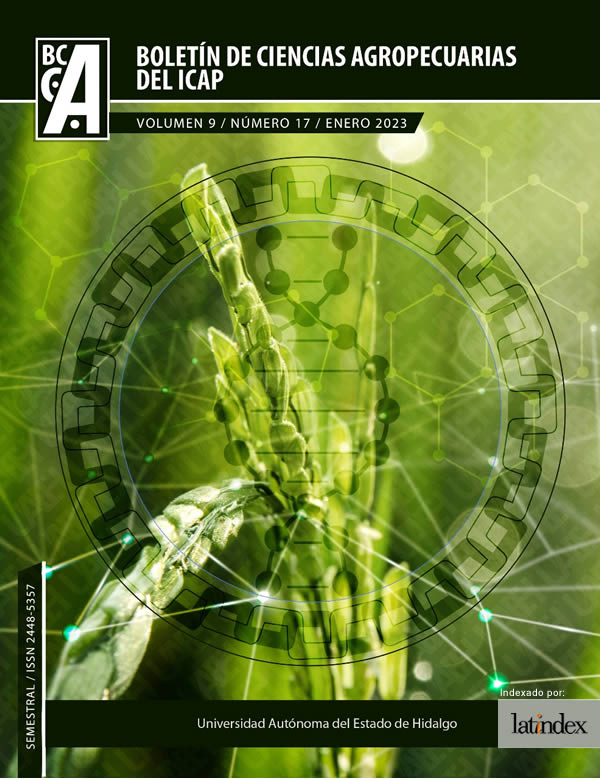Microbiological quality of shrimp samples obtained at point of sale in Tulancingo, Hidalgo
Microbiological quality in shrimp
Abstract
Shrimp consumption has increased considerably due to its multiple health benefits, consumers are currently looking for quality products obtained from sustainable sources, however the production of this product contributes to food safety where there are multiple factors that affect safety, so the objective of this study is to evaluate the microbiological quality of shrimp obtained at different points of sale and that contribute to food safety. In this study, the presence of Salmonella spp., Escherichia coli and Aeromonas spp.; these are considered faecal indicators, which is an important factor for presenting foodborne illness in consumers. In Mexico, national food policies have been implemented for sustainable aquaculture, where productive alternatives are sought to have a greater economic and social impact and where there is a product with high nutritional value that guarantees safety; however, improper handling of this product by handlers or consumers is critical for product contamination.
Downloads
References
[2] Servicio de Información Agroalimentaria y Pesquera (SIAP). Panorama Agroalimentario México, México, 2021; Obtenido de https://nube.siap.gob.mx/gobmx_publicaciones_siap/pag/2021/Panorama-Agroalimentario-2021
[3] Dhar AR, Uddin MT, Roy MK. Assessment of organic shrimp farming sustainability from economic and environmental viewpoints in Bangladesh. Environ Res. 2020; 180:1–40.
[4] de Lima VJ, dos Santos NL, Rodríguez MFG, Vieira MK, Viana SK. An integrated approach to analyzing the effect of biofloc and probiotic technologies on sustainability and food safety in shrimp farming systems. J Cleaner Production. 2021; 318(10):1–8.
[5] Morgan E. Salmonella and Aeromonas Contamination in a 303(d) Listed Water Body Compared to Fecal Indicators & Water Quality Parameters. 2017.
[6] Kim HW, Hong YJ, Jo JI, Ha SD, Kim SH, Lee HJ, Rhee MS. Raw ready-to-eat seafood safety: microbiological quality of the various seafood species available in fishery, hyper and online markets. Letters in appl microbial 2017; 64(1):27–34.
[7] Hamilton KA, Chen A, de-Graft Johnson E. Salmonella risks due to consumption of aquaculture-produced shrimp. Microb Risk Anal. 2018; 9:22-32.
[8] Otzen T, Manterola C. Técnicas de Muestreo sobre una Población a Estudio. I J Morphology. 2017; 35(1), 227-232.
[9] Diario Oficial de la Federación (DOF) 2014. Norma Oficial Mexicana NOM-210-SSA1-2014, Productos y servicios. Métodos de prueba microbiológicos. Determinación de microorganismos indicadores. Determinación de microorganismos patógenos. Obtenido de: http://dof.gob.mx/nota_detalle.php?codigo=5398468&fecha=26/06/2015
[10] Dumen, E., Ekici, G., Ergin, S., & Bayrakal, G. M. 2020. Presence of Foodborne Pathogens in Seafood and Risk Ranking for Pathogens. Foodborne Pathogens and Disease. doi:10.1089/fpd.2019.275310.1089/fpd.20
[11] Barbosa LJ, Ribeiro LF, Lavezzo LF, Barbosa M M, Rossi GA, do Amaral LA. Detection of pathogenic Escherichia coli and microbiological quality of chilled shrimp sold in street markets. Letters in appl microbial. 2016; 62(5):372–378.
[12] Le QP, Ueda S, Nguyen TN, Dao TV, Van Hoang TA, Tran TT, Hirai I, Nakayama T, Kawahara R, Do TH, Vien QM, Yamamoto Y. Characteristics of Extended-Spectrum β-Lactamase-Producing Escherichia coli in Retail Meats and Shrimp at a Local Market in Vietnam. Foodborne pathogens and disease. 2015; 12(8);719–725.
[13] Samayanpaulraj V, Sivaramapillai M, Palani SN, Govindaraj K, Velu V, Ramesh U. Identificación y caracterización de Aeromonas hydrophila Ah17 virulentas de Channa striata infectada en el río Cauvery y evaluación in vitro del quitosano de camarones. Ciencias de la alimentación Nutr . 2020;8(2):1272-1283. Publicado el 20 de enero de 2020. doi:10.1002/fsn3.1416
[14] De Silva B, Hossain S, Dahanayake PS, Heo GJ. Frozen White-Leg Shrimp (Litopenaeus vannamei) in Korean Markets as a Source of Aeromonas spp. Harboring Antibiotic and Heavy Metal Resistance Genes. Microbial drug resistance. 2018, 24(10):1587-1598.
[15] Siddiqee MH, Henry R, Coulthard R, Schang C, Williamson R, Coleman R, Rooney G, Deletic A, McCarthy D. Salmonella enterica Serovar Typhimurium and Escherichia coli Survival in Estuarine Bank Sediments. I J environ res public health. 2018; 15(11):2597.
[16] Patel A, Jeyasekaran G, Jeyashakila R, Anand T, Wilwet L, Pathak N, Malini AH, Neethiselvan N. Prevalence of antibiotic resistant Salmonella spp. strains in shrimp farm source waters of Nagapattinam region in South India. Marine pollution bulletin. 2020; 155:-111171.
[17] Kniel KE, Spanninger P. Preharvest Food Safety Under the Influence of a Changing Climate. Microbiology spectrum. 2017; 5(2):1110-1128.
[18] Diario Oficial de la Federación DOF, 2014. Acuerdo por el que se da a conocer el Plan de Manejo Pesquero de camarón rosado (Farfantepenaeus duorarum), de la Sonda de Campeche.. 3 de marzo de 2014. Obtenido de http://www.dof.gob.mx/nota_detalle.php?codigo=5338728&fecha=28/03/2014
[19] Diario Oficial de la Federación DOF, 2014. Acuerdo por el que se da a conocer el Plan de Manejo Pesquero de camarón iete barbas (Xiphopenaeus kroyeri) en las costas de los estados de Campeche y Tabasco. 4 de marzo de 2014. Obtenido de https://www.dof.gob.mx/nota_detalle.php?codigo=5338845&fecha=31/03/2014
[20] Diario Oficial de la Federación DOF, 2018. Carta Nacional Pesquera. Secretaría de Agricultura, Ganadería, Desarrollo Rural, Pesca y Alimentación. 4 de Mayo de 2018. Obtenido de https://www.gob.mx/cms/uploads/attachment/file/334832/DOF_-_CNP_2017.pdf
Copyright (c) 2023 Vicente Vega Sánchez, Fabián Ricardo Gómez-de-Anda, Andrea Paloma Zepeda-Velázquez, Juan Martin Talavera González, Nydia Edith Reyes Rodriguez

This work is licensed under a Creative Commons Attribution-NonCommercial-NoDerivatives 4.0 International License.










